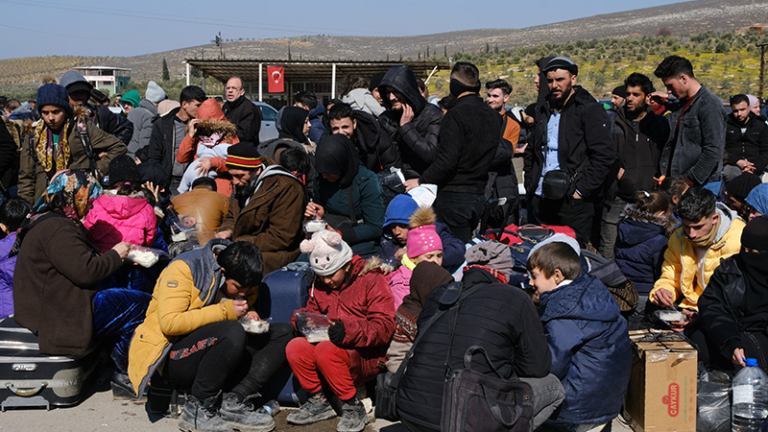
On February 6, 2023, the earth shifted at the fault line that runs along the Turkey-Syria border, resulting in a 7.8 magnitude earthquake, which was followed just hours later by a 7.5 magnitude aftershock. Additional aftershocks in the following days and weeks compounded the horrific toll of the disaster. Over 50,000 people are dead, and countless others are left to grapple with unfathomable physical and emotional trauma.
In the week following the earthquake, people around the world remained glued to their screens, streaming footage of gut-wrenching and heroic rescues, of infants crying as they were pulled from the wreckage, of families being reunited, and of other families being wiped out save for a single individual. In the coverage, the magnitude of the wreckage seemed to sweep across a single swath of land where the earth was churned into a jumble. However, dividing the chaos of the wreckage is a line of legal and political order: the Syrian-Turkish border. Until the war began in Syria in 2011, this border was easily crossed by people visiting friends and family, conducting business, or even just going shopping. Today the border is characterized by rigidity, which is captured in the disparity it generated during this recent catastrophe. While some aid reached Turkish victims, much less made it into Syria. Earthquake victims in Syria, who were already hobbled by years of war and displacement, were forced to fend for themselves in the face of yet another calamity.
Syria Abandoned
On February 12, journalist Zeina Erhaim tweeted a photo depicting the words, “We are dead. Thank you for letting us down,” painted on the rubble of a destroyed building in Syria. The earthquake and its human toll in Syria is as much a story of the cruelty of natural fault lines as it is of human-made political ones. Unlike the droughts, floods, and other extreme weather events that have become emblematic of the global climate crisis, earthquakes are world-shattering natural disasters that are not caused by human action. However, the impact of any disaster, including this one, is disparately felt by people who have unequal access to resources and are disadvantaged within social, economic, and political systems.
The impact of any disaster is disparately felt by people who have unequal access to resources and are disadvantaged within social, economic, and political systems.
The majority of the damage sustained within Syria was in the northwest, in the provinces of Aleppo and Idlib that are hold-outs to the Assad regime’s efforts to reestablish its authority over the entire country. Although all of Syria is suffering from hyperinflation, famine, and unfathomable poverty, this region, which has experienced a longer period of siege and warfare than others, has been uniquely beleaguered by the war. What is more, even before the earthquake, this region was host to at least 2.8 million internally displaced people (IDPs) both from within the region and from other parts of Syria. These are people who, having lost their homes due to deliberate targeting by the Assad regime and now are living in fear of violence and reprisals, are often uniquely disadvantaged within an already dire situation. Prior to the earthquake, over 1.7 million IDPs, over half of whom are children, were residing in camps with extremely limited access to water, sanitation, and healthcare. The remainder had made homes in buildings damaged by years of wartime bombing.
When the earthquake hit, members of Syrian Civil Defense, also known as the White Helmets, who were operating in northwest Syria, and who have more than a decade’s worth of experience pulling bodies from rubble, called on the international community for immediate humanitarian aid since they lacked the necessary equipment to respond to a calamity of this scale. As one member of the White Helmets said in describing the situation, “We pleaded with countries and organizations to send us equipment like heavy machinery through the border in order to lift the rubble. We didn’t want humanitarian aid, food or water. We just wanted the means to save these people.” But the assistance for which the organization asked did not come. The international community decided not to send it.
This was, in large part, due to the closure of borders between Syria and Turkey. In late 2019, Russia, an active ally to the Assad regime and a key actor in the Syrian war, vetoed the reauthorization of border crossings that allow humanitarian assistance to reach communities in Syria without prior approval from the Assad regime. These crossings, in place for years, were widely recognized as life-saving measures to provide a modicum of humanitarian support to Syrians who continue to struggle to satisfy the most basic of human needs. By the time the earthquake struck, only one UN-approved humanitarian border crossing, Bab al-Hawa, remained in place.
The earthquake, however, destroyed the roads leading to Bab al-Hawa. Impacted Syrians and their allies begged countries that regularly proclaim their commitment to humanitarian aid and to protecting the sanctity of human life to use any other border crossings to send equipment they so desperately needed. And Syrian journalists staged a sit-in as not a single convoy crossed the border in the days following the earthquake. But the United Nations would not authorize humanitarian aid to cross at other points without preapproval from the Assad regime. Echoing the same argument that Russia had previously made to veto the renewal of humanitarian border crossings, UN member states argued that to unilaterally deliver aid would impinge on the sovereignty of the Syrian state. To change this position would require another resolution, which some members began to write. But on February 13, the need for a new resolution was rendered moot when, a week after the first earthquake struck, the Assad regime agreed in a closed door meeting to open two additional border crossings for a period of 90 days.
Echoing the same argument that Russia had previously made to veto the renewal of humanitarian border crossings, UN member states argued that to unilaterally deliver aid would impinge on the sovereignty of the Syrian state.
However, the damage had already been done. In a press conference in Geneva on March 13, over a month after the earthquakes struck, Paulo Pinheiro, chair of the UN-backed Independent International Commission of Inquiry on Syria pointed to the United Nation’s slow response as having contributed to the vast number of earthquake-related deaths in northwest Syria, calling it “a wholesale failure by the Government and the international community, including the United Nations, to rapidly direct urgent life-saving support to Syrians in the most dire need.” This absence of aid had disastrous consequences.
A Bad Situation Made Worse
The political unwillingness to save Syrian lives is nothing new. Aid workers have long described the problem of extensive donor fatigue, wherein, as the war draws on, governments, international organizations, and individuals lose interest in supporting Syrians. Data show that aid has systematically and drastically fallen short in the last few years; UNICEF, for instance, only received half of the funding it requested for Syria last year. And an Amnesty International report from 2022 demonstrates the impact of this inadequacy in funding on IDPs, the region’s poorest residents. It describes life in northwest Syria’s displaced persons camps as “unbearable” and characterized by tight quarters, devastating poverty, inadequate healthcare and education, ubiquitous diseases, and rampant gender-based violence against young girls. And recently, cholera has ripped through the camps due to unsanitary conditions. Residents are entirely reliant on informal local efforts and humanitarian aid delivered through the largely inadequate UN cross-border mechanism that so dramatically failed in the aftermath of the earthquake.
Of the 4.5 million people residing in northwest Syria, the United Nations has identified 4.1 million as being in need of aid, 3.3 million as food insecure, and 2.9 million as IDPs, with 1.9 million of them now living in camps.
Today, as a result of the earthquake and the international community’s inadequate response, more people are in dire need of assistance than ever before. Of the 4.5 million people residing in northwest Syria, the United Nations has identified 4.1 million as being in need of aid, 3.3 million as food insecure, and 2.9 million as IDPs, with 1.9 million of them now living in camps whose conditions cannot be better than those described above. Although the opening of additional border crossings means that more food, medical supplies, housing materials, and other basic supplies are now entering Syria, according to Norwegian Refugee Council, a month after the earthquake, the response remains “alarmingly slow.” Less than half of the $400 million in aid that the UN has asked for has been provided, and the only assistance that some in Syria have received in the past month is one bag of bread and some canned food.
Beyond the Syrian Border
The millions of Syrians who live within the borders of their country have extraordinarily limited options. Possibilities for asylum are limited by the same border rigidity that keeps aid out. And although closed borders can be crossed, moving across them often requires payments to smugglers and other intermediaries who charge what are steep fees for people without even the funds to cover their basic needs.
Furthermore, surrounding countries have become more and more hostile. The harsh impact of the earthquake on displaced Syrians also extends across the border into Turkey. Gaziantep, one of Turkey’s largest cities and the epicenter of the earthquake, lies roughly 100 kilometers north of Aleppo. It is host to at least half a million Syrians who have sought refuge there from the war. Syrians in and around Gaziantep, like their counterparts within Syria, are also experiencing re-traumatization and yet another displacement.
Syrian refugees in Turkey are experiencing hate that politicians in Turkey have stirred up against them. Even before the earthquake, Syrians faced racism, violence, and threats of deportation.
Syrian refugees in Turkey are experiencing hate that politicians in Turkey have stirred up against them. Even before the earthquake, Syrians faced racism, violence, and threats of deportation. Human Rights Watch has reported that hundreds of refugees have in fact been deported from Turkey to Syria, making it an unsafe destination for asylum seekers. The earthquake has added fuel to this hatred. In its aftermath, anti-Syrian slogans such as, “We don’t want Syrians,” trended on Turkish Twitter, along with groundless accusations of looting by Syrians.
It is not just Turkey that has become more hostile to Syrians. Over the last few years, other countries in the region have also closed their borders or made conditions harsher for people seeking refuge from Syria. Globally, resettlement processes to countries like the United States and Canada have become more restrictive, and asylum procedures for those trying to cross into Europe have stalled.
The earthquake, while a unique calamity in and of itself, is a continuation of the violence experienced by Syrians at the hands of an international community that has refused to come to their aid. In northwest Syria, the earthquake has claimed the lives of thousands of people. These are lives that were already beleaguered by a war that was joined, rather than being stopped by foreign powers. Taken together, the response to the earthquake, which was delivered through the same limited channels that have long left people in northwest Syria in destitution, stands as a testament to how the world has turned its back on the Syrian people, who are still surviving despite cruel denials of care.
The views expressed in this publication are the author’s own and do not necessarily reflect the position of Arab Center Washington DC, its staff, or its Board of Directors.
Featured image credit: Shutterstock/Tolga Sezgin

